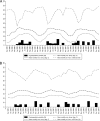Multisite study of cryptosporidiosis in children with diarrhea in India
- PMID: 20392919
- PMCID: PMC2884513
- DOI: 10.1128/JCM.02509-09
Multisite study of cryptosporidiosis in children with diarrhea in India
Abstract
Cryptosporidium spp., a common cause of diarrhea in children, were investigated in the first multisite study in India. Diarrheal stools from hospitalized children aged <5 years from Delhi, Trichy, and Vellore were analyzed by microscopy, PCR-restriction fragment length polymorphism (RFLP), and/or sequencing at the small-subunit (SSU) rRNA and Cpgp40/15 loci for species determination and subgenotyping, respectively. Seventy of 2,579 (2.7%) children, 75% of whom were <2 years old, had cryptosporidial diarrhea as determined by microscopy. Genotyping and subgenotyping showed that Cryptosporidium hominis was the most commonly identified species (59/67 children), and subgenotypes Ie, Ia, Ib, and Id were common in all centers. A novel C. parvum subgenotype, IIn, was identified in Vellore. Meteorological analysis revealed a higher rate of cryptosporidial positivity during hotter and drier weather in Delhi.
Figures




References
-
- Ajjampur, S. S. R., P. Rajendran, I. Banerjee, S. Ramani, B. Monica, P. Sankaran, R. Vivek, R. Sarkar, H. Ward, and G. Kang. 2008. Closing the diagnostic gap in diarrhoea in Indian children by the application of molecular techniques. J. Med. Microbiol. 57:1364-1368. - PubMed
-
- Anisimova, M., and O. Gascuel. 2006. Approximate likelihood-ratio test for branches: a fast, accurate, and powerful alternative. Syst. Biol. 55:539-552. - PubMed
-
- Bushen, O. Y., A. Kohli, R. C. Pinkerton, K. Dupnik, R. D. Newman, C. L. Sears, R. Fayer, A. A. Lima, and R. L. Guerrant. 2007. Heavy cryptosporidial infections in children in northeast Brazil: comparison of Cryptosporidium hominis and Cryptosporidium parvum. Trans. R. Soc. Trop. Med. Hyg. 101:378-384. - PubMed
Publication types
MeSH terms
Substances
Associated data
- Actions
- Actions
- Actions
- Actions
- Actions
- Actions
- Actions
- Actions
- Actions
- Actions
- Actions
- Actions
- Actions
Grants and funding
LinkOut - more resources
Full Text Sources
Medical
Miscellaneous

